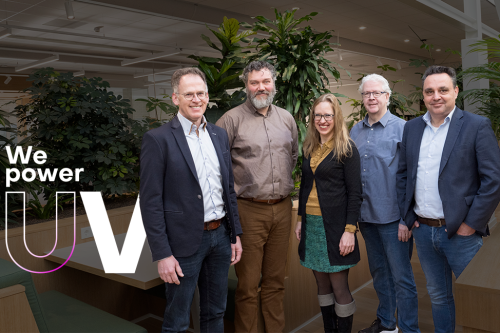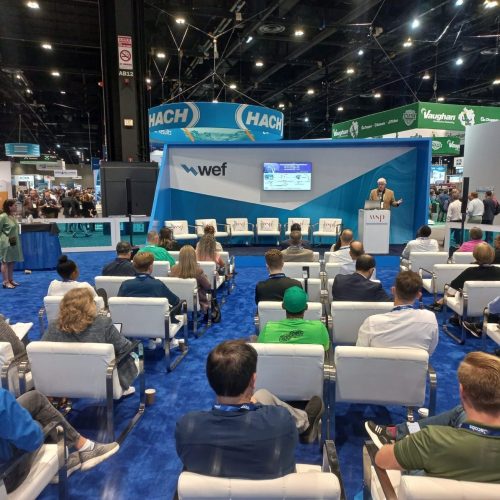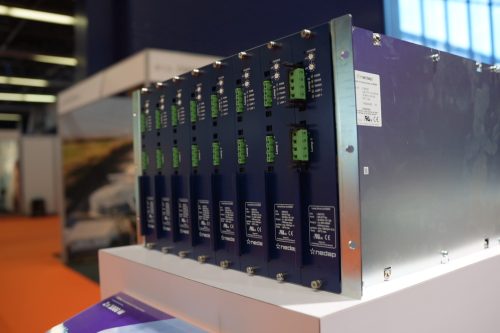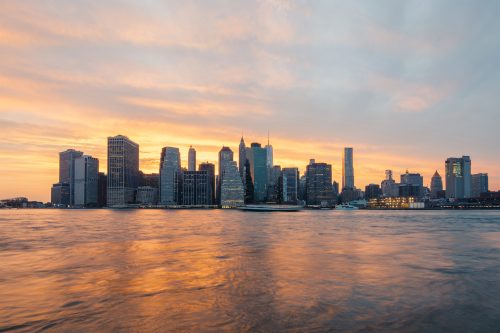René has worked at Nedap for over 25 years. He has been captain of the R&D team for the last eight years and is closely involved in developing our product portfolio, including new driver technologies and solutions. Together with the team, René specialises in translating customer insights into new product features, ensuring we stay at the forefront of innovation.
The R&D team – led by René – is focused on developing UV drivers and platforms with the features our customers need. One relevant example is the ‘smart’ 4/8 kW lamp driver platform, a new product inspired by feedback from our valued customers.

The design of our drivers stands out and delivers high energy efficiency levels. This is important for two reasons. First, it means that less electrical energy is wasted as heat, which is environmentally friendly and results in cost savings for the end user. Second, a high-efficiency product is generally more reliable because it produces less heat stress on components.

At Nedap, we create a genuine, sustainable, and positive impact on the planet by developing solutions that enhance our customers’ success. Our R&D team focusses on creating products that optimize your UV solution’s performance and minimise operational costs.
Nedap’s UV lamp drivers address two key factors: saving energy and reducing service costs. Curious about the mechanism behind it? In this video we unravel the details.
René and his expert colleagues in our R&D department are ready to support your field engineers during the design phase. They are available to provide expert advice and guidance at any stage of the process, working with you to unlock efficiencies and improve environmental protection.
Want to know how our UV driver technology can power your ambitions? Let’s discover it together.

Ozon oxidation and UV advanced oxidation haven proven to be effective technologies for removal of micro-pollutants in wastewater. Because these technologies use (renewable) electrical energy and produce no waste, they have potential to help water utilities to reduce the CO2-footprint and reach their neutrality target.
We partner with UV professionals globally to create energy efficient UV systems at the lowest total costs of ownership. Integrating energy efficient UV drivers helps to reduce operational costs and carbon footprint, creating future proof UV systems.
On January 29th, the Council and the European Parliament’s negotiators reached a provisional political agreement on a proposal to review the urban wastewater treatment directive. The revised directive is one of the key deliverables under the EU’s zero-pollution action plan.
In the agreement, the co-legislators aligned the thresholds and timelines for quaternary treatment (the removal of a broad spectrum of micro-pollutants). By 2045, Member states will have to ensure the application of quaternary treatment in larger plants of 150,000 population equivalent and above, with intermediate targets in 2033 and 2039 for quaternary treatment.

Energy neutrality and renewables
The co-legislators also agreed that the urban wastewater treatment sector could play a significant role in significantly reducing greenhouse gas emissions and helping the EU achieve its climate neutrality objective. They introduced an energy neutrality target, meaning that by 2045 urban wastewater treatment plants will have to produce energy from renewable sources, based on regular energy audits, with progressive intermediate targets. This energy can be produced on or off-site, and up to 35% of non-fossil energy can be purchased from external sources. This percentage only applies to the final target.
Designing systems with optimal electrical efficiency has always been our focus. Now it’s even more relevant because of the sustainability ambitions of governments.

Energy efficiency is increasingly important for governments and industries. It is seen as the first building block for any energy strategy and stated in the COP28 declaration. In Germany, wastewater treatment facilities currently account for 20% of energy consumption, making them the biggest municipal energy consumers (source: FONA). In the coming decades, a further shortage of conventional energy sources and an increase in energy costs can be expected. Increasing energy and resource efficiency in water management is therefore of crucial importance worldwide.

Advancements in oxidation technologies
The opportunity for advanced oxidation processes (AOPs) in water and wastewater treatment is growing concurrently with the increasing drive towards water reuse and stricter regulations for wastewater discharge. This brings AOPs to the forefront of dealing with new treatment challenges.
Leading the way
With more than 16,000 publicly owned wastewater treatment systems, the United States forms a large potential market for UV vendors. The industry is familiar with UV-hydrogen peroxide treatment due to several decades of experience. UV treatment coupled with the addition of hydrogen peroxide is the most commonly employed AOP for municipal water and wastewater, either for drinking water or municipal water reuse. This is due to the simple fact that it often comes out as the most cost-effective solution. The UV/hydrogen peroxide combination has been installed in major treatment plants since the early 2000s, with the 2008s Orange County, CA being the first ‘toilet-to-tap’ treatment plant in the USA.

Combining technology increases effectiveness and efficiency
Ozon oxidation and UV advanced oxidation have proven to be effective technologies for removal of micro-pollutants in wastewater. Because these technologies use (renewable) electrical energy and produce no waste, they have potential to help water utilities to reduce the carbon footprint and reach their neutrality target. Several pilots have been conducted to compare the carbon footprint (meanly energy costs) of UV peroxide oxidation and ozonation with other technologies, like Granular Activated Carbon (GAC) or Powdered Activated Carbon in Activated Sludge (PACAS).
> Image: The MicroForce++ technology combines ozonation and biological oxidation and has a removal efficiency of 80%, low carbon footprint and low cost per m3 treated water.

Customization being the standard
The pilots and full-scale applications have set a clear rule: there is no one size fits all approach. The make-up of streams that require treatment varies wildly from industry to industry (and sometimes between streams in one facility) and technology application requires large amounts of customization. Full scale pilot studies do show that when combining filtration technologies with ozonization or an AOP step with UV and hydrogen peroxide, the removal efficiencies greatly increase. This results in high quality water that for example can be reused in the industrial processes.
> Image: The Ozone treatment technology of MicroForce shows that the total CO2 footprint only slightly increases compared to the reference situation without post-treatment, and that this increase is almost entirely due to the energy required to generate and introduce the ozone.

Lower CO2 Footprint of UV Treatment
Dutch research conducted by Witteveen + Bos (2023) showed that UV peroxide oxidation technology can have a lower or comparable environmental impact in certain cases compared to activated carbon and ozonation. This is highly dependent on the UV transmission of the wastewater. Higher transmission means lower energy consumption. In case of low transmission, the wastewater can be pretreated with a sand filter and flocculation.
> Image: The Advanox AOP system combines UV-C light with hydrogen peroxide to effectively break down micro-pollutants. The CO2- footprint primarily consists of the required electronic energy. This consumption is the smallest when the water has high transmission values (70% T10); then the technology works most efficiently, and the CO2 footprint is lower compared to other technologies. If renewable energy is also utilized, the impact decreases even further.
Source: H2OWaternetwerk.nl (Sept. 2023)

How Nedap UV driver technology helps to reduce energy consumption
Within the proven UV technology, there are two main streams: low-pressure and medium-pressure systems. Low-pressure UV systems are more energy-efficient compared to the more compact medium-pressure systems. By accurately and smartly controlling the large, multi-lamp systems, the system can become even more energy efficient. The electrical efficiency of the UV lamp drivers also makes a difference. This is exactly what distinguishes Nedap driver technology.
> Image: St Anthony Village is the 35th public water system in North America to specifically treat 1,4 Dioxane using Advanced Oxidation with UV-Peroxide. The six (6) Trojan UVPhox Reactors each contain 144 low-pressure high-output UV lamps. The overall system can remove more than 99% of 1,4 Dioxane at Peak Flow Conditions of 3,000 GPM. Source: www.health.state.mn.us (August 2017)

Contact us
Nedap is dedicated to reducing our environmental footprint through smart driver technology that meets current regulations and anticipates future trends. Get in touch to discover how our team can support your business.

We will be showcasing our latest innovations at the NL Pavilion during IFAT, the world’s leading trade fair for water, sewage, waste, and raw materials management, from May 13-17, 2024, in Munich, Germany.
Come and meet our team at Booth 217-316, Hall 3 to explore new opportunities, share insights, and learn more about our contributions to the water sector.
Our team at IFAT: Richard Hogenkamp, Pieter Feenstra, Olga Kruidhof, Tonnie Telgenhof Oude Koehorst and Peter Wolberink.






Nedap will participate in the International Ultraviolet Association (IUVA) World Congress taking place at the Hyatt Regency Orlando in Orlando, Florida on May 20-22, 2024.
This event is co-located with RadTech 2024.






Join Nedap UV at the WEFTEC 2024 Exhibit! This event will take place at the Ernest N. Morial Convention Center in New Orleans, Louisiana, USA, from October 5 to October 9, 2024.






AQUATECH 2023: A recap
Earlier this month, Nedap was proud to exhibit at the Aquatech Amsterdam trade show. Held from the 6th to the 9th of November at Amsterdam RAI, AQUATECH 2023 was the biggest event of its kind so far, with more than 1,000 exhibiting companies and drawing over 25,000 professional visitors. Attendees explored trends around wastewater treatment, purification methods and more.
Growing global awareness of water treatment and storage challenges, driven by climate change and population growth, fuels interest in each part of the water supply chain. Through presentations and networking areas on all kinds of water-related topics, AQUATECH 2023 showcased innovative solutions and new developments that could mitigate some of the world’s most pressing challenges.
At Aquatech, new pilot schemes were presented, showcasing energy-neutral treatment projects and resource-efficient initiatives looking to reduce water waste and lower carbon footprints. Additionally, new business models were also presented, including ‘wastewater-as-a-service’.

The issue of polyfluoroalkyl substances (PFAS) and other forms of so-called “forever chemicals” was another important topic featured at the show. It is clear that a ‘tech stack’ of solutions will be necessary to deliver unity in this market.

Another topic presented during the show surrounded the removal of pharmaceuticals and agricultural additives from sewage water. Treatment plants are setting up pilots to test different combinations of technologies, mostly driven by regulations such as the European Framework Directive (2027) and the European Wastewater Directive (2030).

For many industries, compliance with regulation is a driving force in treating wastewater streams. It is clear that depending on the situation, application, and the stream of wastewater itself, a ‘tech stack’ of solutions is also required in this area.

Technology developments



During pilot studies of these three approaches, crucial parameters, including carbon footprint reduction, waste minimisation, and the cost per cubic metre of treated water, were key considerations.
Nedap witnessed the importance of applying a ‘tech stack’ approach to both proven and new solutions. By integrating UV technologies with innovations like ultra or nano-filtration technology, superior results were achieved, eliminating 70 to 80% of micropollutants from sewage and wastewater. In Ozone water treatment, UV is used to deplete unwanted byproducts.
Concerning ozone water treatment, UV light is used to deplete unwanted byproducts. Advanced oxidation processes (AOP) use UV light to reduce low-molecular-weight contaminants that may bypass Reverse Osmosis (RO) membranes, such as pharmaceutical residues, endocrine disruptor chemicals, or industrial solvents. The UV AOP process requires using UV light along with an oxidant, such as hydrogen peroxide or chlorine, to enhance the purification process.
At Aquatech, we observed a growing interest in UV technology as a sustainable solution for water treatment. Our sustainable driver technology helps utilities in lowering carbon footprint during operation. Additionally, the extended lifespan of Nedap drivers, significantly reduces the total cost of ownership. Eager to experience the impact? Use our digital calculator to estimate your savings.

As a hub of water professionals from all over the world, AQUATECH 2023 offered a perfect chance to network and share insights with industry peers.
To find out more regarding the exciting developments and thought-provoking debates that emerged at AQUATECH 2023, as well as the ongoing role that Nedap expects to play in the fast-moving world of water treatment, get in touch with us!

In our continuous pursuit of sustainable and intelligent solutions, we are thrilled to present our latest collaborative project. We’ve teamed up with ‘Meneer Wietsma’, a teacher and popular Dutch science YouTuber, to bring you an insightful video on the role of UV light and water purification.

UV technology has endless applications, many of which remain unknown to the younger generation. To bridge this gap and ignite curiosity, we collaborated with ‘Meneer Wietsma’. After all, in today’s digital age, what better way to capture attention than through engaging online content? Check out the video learn about UV light, form water purification to industrial innovations.
At Nedap, we’re passionate about UV light and its powerful applications, from industrial processes to essential water purification. Collaborating with Meneer Wietsma to create this educational video is an exciting opportunity for us to share our enthusiasm and knowledge in the field. For any further inquiries or more information on this topic, feel free to contact the our team.





To make the Unimulti Lamp Driver more universally applicable, the input voltage range has been extended. This new version now also supports the North American standard input voltage of 120Vac.

UV disinfection and industrial curing are highly sustainable processes that reduce the use of chemicals. UVC has been used as far back as the 1930s, but the technology remains relevant today – and Nedap is increasing innovation in the sector.
New developments in curing and disinfection are accelerating the growth of the UV market. At Nedap, we support UV businesses to develop new applications and further optimize processes for more sustainable disinfection and curing.
- Electronic lamp driver technology that excels in quality and energy-efficiency
- Smart technology that can quickly be adopted and deployed
- Accessible data, information, and insights

An incredible 75% of the lifecycle costs of UV solutions are energy usage. Using energy-efficient UV lamp driver technology is a sustainable solution, reducing a user’s carbon footprint and cutting costs.

Advanced electronic driver technology offers manufacturers more control over the power input versus UV output. This makes UV solutions more efficient at disinfection or curing when compared to traditional magnetic ballast technology.
The new generation of platforms, such as Nedap’s 4kW, use a PC lamp driver tool that makes it easy to configure, control and monitor lamp driver data. This provides developers with more effective tools to test the lamp driver and the overall UV solution, optimizing it during the design phase.

Water disinfection systems typically operate 24/7, with downtime dramatically impacting productivity and the people who rely on the resource.
Current monitoring systems alert operators if a UV driver goes down but don’t diagnose faults. Instead, special measurement tools are often required on-site to diagnose problems which can rapidly increase costs and increase downtime.

Nedap’s solution provides real-time monitoring, alerts, diagnosis, and fault finding. Service engineers receive instant access to performance information and insights without disrupting the operational processes controlled by Modbus.
Rapid troubleshooting is critical to ensure minimal downtime.
Remote diagnostics can dramatically reduce travel costs and time. Our customers supply UV solutions worldwide, including some of its remotest places. Remote monitoring technology provides real-time insights whenever they need them, from anywhere in the world. The app is a critical first step toward accurate remote diagnostics.
To protect the security of systems, the Nedap UV lamp driver App ensures that data is only read from the connected lamp driver and no control and change of settings of the lamp driver is allowed. No connection to the Internet is needed to read data from the driver. The communication between the lamp driver and smart phone is local via a point-to-point wireless Bluetooth connection.
Every lamp driver has a unique 3D barcode. Scanning the barcode creates a connection between the smartphone and the lamp driver, displaying data and lamp graphs through the app.
The UV Monitor app will be available in the App Store and Google Play store from February 2023.

Nedap’s next-generation lamp driver platform has updated integrated software. This gives operators more data and control over settings and parameters compared to previous models. However, this can lead to more complexity. To make data relevant for users, it’s essential to provide easy access and deliver relevant insights. In this way, data leads to a more sustainable and cleaner operation.
Do you want to know more about how to use the Nedap UV Monitor app?
Contact us or download the manual (PDF) below:










